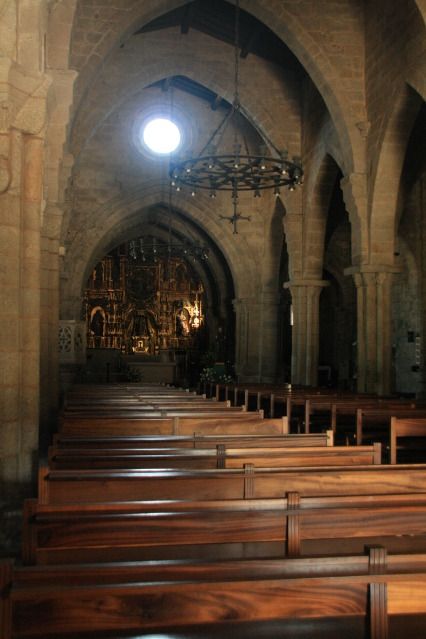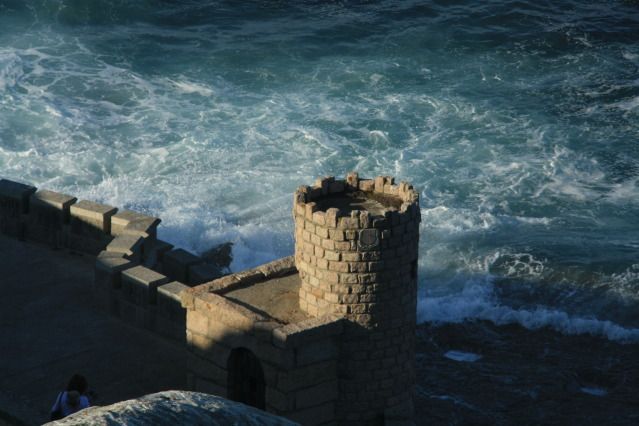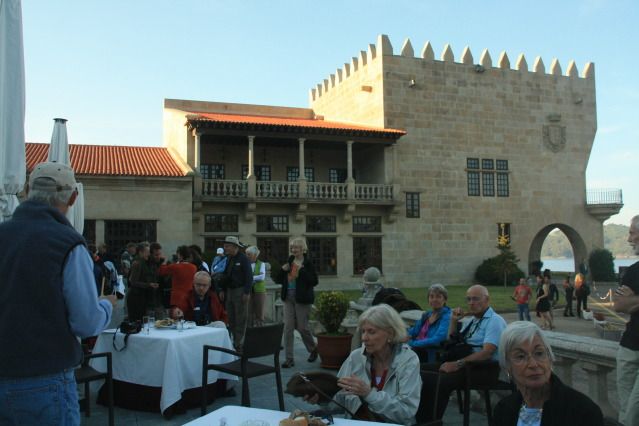Isle de Cies and Baiona, Spain
October 4 - In the early hours of the day we sailed across the last of a surprisingly calm Bay of Biscay nearing the juncture with the Atlantic Ocean.
[Read More]
As a beautiful dawn broke over the sea we approached the Isle de Cies, a small group of three islands off the north coast of Spain that are part of the National Maritime Park.

In the early light of morning we approached the sheltered anchorage on the landward side of the largest island and anchored in the bay. We boarded our zodiacs to go ashore and spend some leisurely time exploring these peaceful islands.

From the dock a short wooden bridge crossed the dunes so as not to disturb them and then entered the fragrant pine woods that cover much of the island.

Once into the woods we followed a nice, smooth path through the woods and around one end of the bay in which our ship was anchored.

After a short walk we reached the seaward side of the island which presented a far different appearance than that towards the bay. Here the large waves off the Bay of Biscay crashed with tremendous force against the steep, rocky slopes of the island.


We spent an hour or so walking around the island. It was so lovely and so very peaceful, especially after the hectic pace of the previous two weeks. Here one had time to take notice of the light hitting the leaves and of the beautiful flowers.


From higher up on the slopes of the central part of the island we had a spectacular view of the bay with the hills of mainland Spain in the distance.

As we walked back toward the pier to rejoin the ship we watched a huge flock of gulls taking flight from the beach and going out in search of breakfast.

Leaving the islands behind we sailed across the bay to the Spanish town of Baiona. It was founded in 140 BC by Diomedes of Aetolia. Throughout its history it has had several names including Stuciana, Abóriga, Balcagia, and Erizana.
One of the first things noted on entering the harbor is the imposing Castelo de Montrereal which sits atop the pinnacle of one of the arms of land protecting the harbor. The Castelo was begun in the 14th century and completed in the 16th century seeing the fortifications go from one designed to repel pre-gunpowder weapons to one that mounted the cannons that repelled an attack by Sir Francis Drake.


Today was to be a day at leisure until it was time for a special dinner ashore. We embarked in our zodiacs and went in to the local pier where we found this amusing shot.

After our green friend gave us leave to pass we began our stroll around the town. We soon found a plaque commemorating the fact that on March 1, 1493, the Pinta, one of the ships from Columbus' voyage to discover the New World returned to Europe and arrived in Baiona, making the town's port the first to receive news of the discovery of America

We wandered largely deserted streets through the old town as it was siesta and most of the locals were in their homes from noon until shops reopened at four o'clock.

One of the things we were impressed by was that many of the older buildings had intricate ceramic tilework on the outside of the buildings. This served both as a decorative feature and also as a means of protecting the walls from the elements.

In one of the residential areas of the old town we found this lovely example of a Romanesque church. Built in the 1400's it is still actively serving the local neighborhoods today.

The altar screen in the church dates from the later Baroque period with lavish applications of gilt wood.

After leaving the church we decided to walk up the hill and explore the Castelo de Montereal. From the top of the ramparts we had a lovely view of Baiona and its harbor.

As we walked further outward along the ramparts away from the town we reached the point where the walls faced outwards into the empty vastness of the Atlantic where waves crashed against the foot of the rocky headland. Before the voyages of Columbus this would have been the furthest westward that Spanish influence would have reached. This causes us the christen the Castel as the "Fortress at the End of the World".



At one point the fortress walls lead all the way down to the very edge of the sea.

Dinner tonight was to be a special experience of Spanish food which we would enjoy at the Parador de Baiona in the middle of the Castelo. All of the Paradors in Spain were begun in the 1920's as a way to encourage tourism and all of them are located in monasteries and castles such as the Castelo.
As dusk began to fall we gathered on the portico at the Parador to enjoy Spanish wine and tapas. I couldn't quite find my way clear to sample the octopus-on-a-stick, but many of the other selections were quite good.


After our appetizer course on the patio we went into the lovely dining room for out main meal.

Dinner began with a salad course accompanied by white wine. Then we moved on to the main course. We had been able to choose in advance what our entree would be that night. For those choosing fish there was a dover sole that I was told was quite good. Blake and I had both opted for the lamb in almond sauce that was absolutely delicious! For desert there as a crispy pastry tube filled with orange cream and decorated with fresh berries. It was a truly memorable dinner.
After our meal we travelled back to town by bus and boarded our zodiac to ride back to the ship across a harbor spangled with colored lights. As soon as everyone was back on board we set sail again. Tonight we will round the tip of Spain and head down the Portugese coast.
[Read More]
As a beautiful dawn broke over the sea we approached the Isle de Cies, a small group of three islands off the north coast of Spain that are part of the National Maritime Park.

In the early light of morning we approached the sheltered anchorage on the landward side of the largest island and anchored in the bay. We boarded our zodiacs to go ashore and spend some leisurely time exploring these peaceful islands.

From the dock a short wooden bridge crossed the dunes so as not to disturb them and then entered the fragrant pine woods that cover much of the island.

Once into the woods we followed a nice, smooth path through the woods and around one end of the bay in which our ship was anchored.

After a short walk we reached the seaward side of the island which presented a far different appearance than that towards the bay. Here the large waves off the Bay of Biscay crashed with tremendous force against the steep, rocky slopes of the island.


We spent an hour or so walking around the island. It was so lovely and so very peaceful, especially after the hectic pace of the previous two weeks. Here one had time to take notice of the light hitting the leaves and of the beautiful flowers.


From higher up on the slopes of the central part of the island we had a spectacular view of the bay with the hills of mainland Spain in the distance.

As we walked back toward the pier to rejoin the ship we watched a huge flock of gulls taking flight from the beach and going out in search of breakfast.

Leaving the islands behind we sailed across the bay to the Spanish town of Baiona. It was founded in 140 BC by Diomedes of Aetolia. Throughout its history it has had several names including Stuciana, Abóriga, Balcagia, and Erizana.
One of the first things noted on entering the harbor is the imposing Castelo de Montrereal which sits atop the pinnacle of one of the arms of land protecting the harbor. The Castelo was begun in the 14th century and completed in the 16th century seeing the fortifications go from one designed to repel pre-gunpowder weapons to one that mounted the cannons that repelled an attack by Sir Francis Drake.


Today was to be a day at leisure until it was time for a special dinner ashore. We embarked in our zodiacs and went in to the local pier where we found this amusing shot.

After our green friend gave us leave to pass we began our stroll around the town. We soon found a plaque commemorating the fact that on March 1, 1493, the Pinta, one of the ships from Columbus' voyage to discover the New World returned to Europe and arrived in Baiona, making the town's port the first to receive news of the discovery of America

We wandered largely deserted streets through the old town as it was siesta and most of the locals were in their homes from noon until shops reopened at four o'clock.

One of the things we were impressed by was that many of the older buildings had intricate ceramic tilework on the outside of the buildings. This served both as a decorative feature and also as a means of protecting the walls from the elements.

In one of the residential areas of the old town we found this lovely example of a Romanesque church. Built in the 1400's it is still actively serving the local neighborhoods today.

The altar screen in the church dates from the later Baroque period with lavish applications of gilt wood.

After leaving the church we decided to walk up the hill and explore the Castelo de Montereal. From the top of the ramparts we had a lovely view of Baiona and its harbor.

As we walked further outward along the ramparts away from the town we reached the point where the walls faced outwards into the empty vastness of the Atlantic where waves crashed against the foot of the rocky headland. Before the voyages of Columbus this would have been the furthest westward that Spanish influence would have reached. This causes us the christen the Castel as the "Fortress at the End of the World".



At one point the fortress walls lead all the way down to the very edge of the sea.

Dinner tonight was to be a special experience of Spanish food which we would enjoy at the Parador de Baiona in the middle of the Castelo. All of the Paradors in Spain were begun in the 1920's as a way to encourage tourism and all of them are located in monasteries and castles such as the Castelo.
As dusk began to fall we gathered on the portico at the Parador to enjoy Spanish wine and tapas. I couldn't quite find my way clear to sample the octopus-on-a-stick, but many of the other selections were quite good.


After our appetizer course on the patio we went into the lovely dining room for out main meal.

Dinner began with a salad course accompanied by white wine. Then we moved on to the main course. We had been able to choose in advance what our entree would be that night. For those choosing fish there was a dover sole that I was told was quite good. Blake and I had both opted for the lamb in almond sauce that was absolutely delicious! For desert there as a crispy pastry tube filled with orange cream and decorated with fresh berries. It was a truly memorable dinner.
After our meal we travelled back to town by bus and boarded our zodiac to ride back to the ship across a harbor spangled with colored lights. As soon as everyone was back on board we set sail again. Tonight we will round the tip of Spain and head down the Portugese coast.